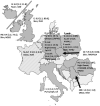Genetic and geographic influence on phenotypic variation in European sarcoidosis patients
- PMID: 37621457
- PMCID: PMC10446882
- DOI: 10.3389/fmed.2023.1218106
Genetic and geographic influence on phenotypic variation in European sarcoidosis patients
Abstract
Introduction: Sarcoidosis is a highly variable disease in terms of organ involvement, type of onset and course. Associations of genetic polymorphisms with sarcoidosis phenotypes have been observed and suggest genetic signatures.
Methods: After obtaining a positive vote of the competent ethics committee we genotyped 1909 patients of the deeply phenotyped Genetic-Phenotype Relationship in Sarcoidosis (GenPhenReSa) cohort of 31 European centers in 12 countries with 116 potentially disease-relevant single-nucleotide polymorphisms (SNPs). Using a meta-analysis, we investigated the association of relevant phenotypes (acute vs. sub-acute onset, phenotypes of organ involvement, specific organ involvements, and specific symptoms) with genetic markers. Subgroups were built on the basis of geographical, clinical and hospital provision considerations.
Results: In the meta-analysis of the full cohort, there was no significant genetic association with any considered phenotype after correcting for multiple testing. In the largest sub-cohort (Serbia), we confirmed the known association of acute onset with TNF and reported a new association of acute onset an HLA polymorphism. Multi-locus models with sets of three SNPs in different genes showed strong associations with the acute onset phenotype in Serbia and Lublin (Poland) demonstrating potential region-specific genetic links with clinical features, including recently described phenotypes of organ involvement.
Discussion: The observed associations between genetic variants and sarcoidosis phenotypes in subgroups suggest that gene-environment-interactions may influence the clinical phenotype. In addition, we show that two different sets of genetic variants are permissive for the same phenotype of acute disease only in two geographic subcohorts pointing to interactions of genetic signatures with different local environmental factors. Our results represent an important step towards understanding the genetic architecture of sarcoidosis.
Keywords: genetic polymorphism; genetic risk factors; genotype–phenotype-relationship; region-specific genetic links; sarcoidosis.
Copyright © 2023 Freitag-Wolf, Schupp, Frye, Fischer, Anwar, Kieszko, Mihailović-Vučinić, Milanowski, Jovanovic, Zissel, Bargagli, Rottoli, Bumbacea, Jonkers, Ho, Gaede, Dubaniewicz, Marshall, Günther, Petrek, Keane, Haraldsdottir, Bonella, Grah, Peroš-Golubičić, Kadija, Pabst, Grohé, Strausz, Safrankova, Millar, Homolka, Wuyts, Spencer, Pfeifer, Valeyre, Poletti, Wirtz, Prasse, Schreiber, Dempfle and Müller-Quernheim.
Conflict of interest statement
FB received from Boehringer Ingelheim, Fujirebio, Galapagos NV and Roche; personal travel support from Boehringer Ingelheim and Roche, board membership fees from Boehringer Ingelheim, Bristol Myers Squibb, Fujirebio, Galapagos, GlaxoSmithKline, Roche and Takeda. DB grants paid to the institution from Synairgen and Sanofi; personal honoraria received from Chiesi, Norvatis and Sanofi; personal honoraria for lectures received from Astra Zeneca, Eli Lilly and Norvatis; not for profit activities for ministry of health, Romania. AF received a grant from the German Research Foundation. BF: received grants from Bristol Myers Squibb and AdVita Lifescience paid to the institution; personal honoraria for lectures from Boehringer Ingelheim, Astra Zeneca and Roche, personal travel support from Boehringer Ingelheim; reports a pending patient WO2020225246A1 and stocks from Relief Therapeutics. CG received lecture fees from Astra Zeneca paid to the institution. MK received consulting fees from Boehringer Ingelheim. JM-Q grants from German Research Council, Bristol Myers Squibb and AdVita Lifesciences paid to the institution, received personal honoria from AdVita Lifesciences and Roche, received lecture fees from Astra Zeneca and Roche, received payments for expert testimony from AdVita Lifescience; received travel support from AdVita Lifescience and Grifols, reports a pending patent WO2020225246A1 and stocks from Relief Therapeutics. MaP received grants from Palacky University paid to the institution. MiP reports fiduciary activities for Deutsche Gesellschaft für Pneumologie und Beatmungsmedizin. VP received personal consulting fees from Ambu and Erbe; lecture honoraria from Boehringer Ingelheim and Roche and participated in a data safety monitoring board for Boehringer Ingelheim. AP received personal consulting fees from Boehringer Ingelheim, Roche, AstraZeneca and Galapagos, lecture fees from Boehringer Ingelheim, Norvatis and Gilead, participated in data safety monitoring boards for Boehringer Ingelheim, Roche and AstraZeneca and reports fiduciary activities for the European Rare Disease Network Interstitial Lung Disease Group and the steering committee of the World Association of Sarcoidosis and Other Granulomtous Disorders. SS reports grants from the German Research Council paid to the institution, personal consulting fees from Abbvie, Arenal, BMS, Biogen, Celltrion, Celgen, IMAB, Gilead, MSD, Mylan, Pfizer, Fresinius, Janssen, Takeda, Theravance, Provention Bio, Protagonist, Falk, Ferring, UCB, Amgen, Sandoz Hexal, Lilly, Galapagos. JCS grants from the German Research Council, Else Kröner-Fresenius Foundation, and Fritz Thyssen-Foundation paid to the institution; received personal lecture honoraria from Boehringer Ingelheim. LS received personal honoraria from Boehringer Ingelheim for educational events. D received personal honoraria from Boehringer Ingelheim for activities in advisory boards and lecture fees from Boehringer Ingelheim and AstraZeneca and reports travel support from Boehringer Ingelheim. WW grants from Roche, Boehringer Ingelheim, and Galapagos, consulting fees from Sanofi, Boehringer Ingelheim and Roche, honoraria for lectures from Roche and Beohdringer Ingelheim and payments for activities in data safety monitoring boards from Boehringer Ingelheim and Roche all paid to the institution. GZ reports a pending patent (EP 2585089 A1) and stock options for Moderna, Biontech and Relief Therapeutics. The remaining authors declare that the research was conducted in the absence of any commercial or financial relationships that could be construed as a potential conflict of interest.
Figures



References
LinkOut - more resources
Full Text Sources
Research Materials

